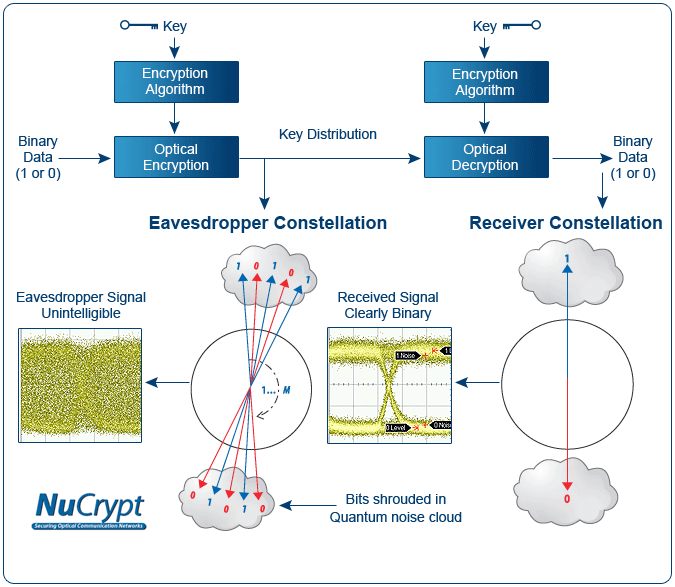AlphaEta™ Cryptography Concept
Introduction To Concept
 Optical signals are almost always transmitted in a binary format, where each symbol transmitted is either "1" or a "0". Recently very advanced high performance optical systems have started sending data in quaternary format, where two bits of data are transmitted with every symbol. This is quite unlike some other data transmission systems, such as those used in wireless internet (Wi-Fi) or digital subscriber line (DSL) modems, which typically send 16, 32, or even 256 bits every symbol. Such advanced modulation schemes have enabled phone lines to carry up to and beyond a megabit per second of data. Why not take advantage of this in the optical domain? One reason is that optical signal-to-noise issues make it hard for optical technology to have a clean enough signal to allow for these more complex modulation formats. While this is disappointing for super-high rate communication applications, it turns out to be useful for encryption. Optical signals are almost always transmitted in a binary format, where each symbol transmitted is either "1" or a "0". Recently very advanced high performance optical systems have started sending data in quaternary format, where two bits of data are transmitted with every symbol. This is quite unlike some other data transmission systems, such as those used in wireless internet (Wi-Fi) or digital subscriber line (DSL) modems, which typically send 16, 32, or even 256 bits every symbol. Such advanced modulation schemes have enabled phone lines to carry up to and beyond a megabit per second of data. Why not take advantage of this in the optical domain? One reason is that optical signal-to-noise issues make it hard for optical technology to have a clean enough signal to allow for these more complex modulation formats. While this is disappointing for super-high rate communication applications, it turns out to be useful for encryption.
AlphaEta™ encryption works by translating a binary signal and a pseudo-random bit stream generated using state-of-the-art cryptographic algorithms into a very dense constellation. By designing the system properly, we can make it physically impossible to distinguish between the various states being transmitted. This adds both complexity and true random noise to any unauthorized observation of the transmitted signal. However, on the receiver side, the same cryptographic algorithm can be used to re-translate the received signal back into a binary format where the data is easily observed.
 Although AlphaEta™ makes use of quantum noise, it does so in such a way that it is still capable of high-rate long distance propagation through common optical infrastructure, such as Erbium doped fiber amplifiers and dense wavelength division multiplexers (DWDM). For instance, an AlphaEta™ encrypted channel can replace a single DWDM channel in most typical all optical networks. It is also worth noting that it is compatible with both fiber-optic and free-space optical systems. Additionally, AlphaEta™ is constructed using commercially available off-the-self components. Thus it is both quite flexible and carries with it a low cost of ownership. This combination of ultrahigh security, flexibility, and low cost makes this new noise-based cryptography the first optical physical encryption system of significant market interest.
Real World Implementation: Ultrahigh security is a critical issue in military and corporate communications. But to be deployed, it must come at a reasonable cost and convenience. NuCrypt’s AlphaEta™ uses commercially available off-the-shelf components and is compatible with traditional optical infrastructure. It operates at high data rates, making it the first practical, physics-based ultrahigh security optical encryption technology on the market.
- The bandwidth explosion has led to a corresponding growth in the transmission of sensitive information, such as financial, medical and legal records, as well as homeland security and first responder communications.
- Since traditional encryption schemes are not provably secure, there is a continued need to utilize every possible tool to enhance the secrecy of critical communications.
- Effective security is usually built in layers. Therefore, multiple layers of security oriented technologies are required to thwart the many possible types of attacks.
New physics-based methods for the first time allow quantifiable security characteristics and, thus, are a better method of security.
Back To Noise-Based Physical Layer Encryption
|